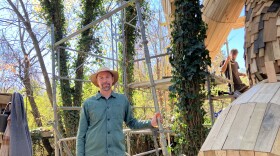The Bodie Island Lighthouse is one of the last of its kind. And on Saturday, Nov. 12, the public is invited to help celebrate the tower's unique history at a free event.
Situated just south of Nags Head and four miles north of the Oregon Inlet in North Carolina’s Outer Banks, the structure is one of about a dozen remaining tall, brick lighthouses in the country. It’s also part of an even more exclusive club because it's one of just 10 still-functioning lighthouses in the U.S. that uses a first-order Fresnel lens to shine its light. The first-order lens is the largest one made, says Tom Avery of the Bodie Island District of the National Park Service.
“The Fresnel lens really innovated the lighthouse system,” Avery said. “It captures almost all the light, there's almost no wasted light, and each prism focuses all the light down onto one horizontal plane."
The lighthouse — built in 1872 — is celebrating its 150th birthday at 4 p.m. on Saturday. The Cape Hatteras National Seashore, in partnership with Outer Banks Forever and the Outer Banks Lighthouse Society, will host a ceremony at the lighthouse that is free and open to the public.
The event will be highlighted by remarks from officials with the Cape Hatteras National Seashore, the U.S. Coast Guard, the Outer Banks Lighthouse Society, and descendants of former lighthouse keepers. Visitors will be able to check out temporary displays and exhibits in the keepers’ quarters and in the base of the lighthouse.
Many guests will also be climbing the lighthouse, but that required a reservation. A National Park Service spokesperson told WUNC that those tickets are all spoken for.
Following messages from scheduled speakers, all visitors to the lighthouse on Saturday afternoon will be able to see a lighting of the Fresnel lens, which has a range exceeding 18 miles.
This celebration was originally scheduled for Oct. 1 — the day in 1872 that the lighthouse was first lit — but was pushed back due to Hurricane Ian.

Destroyed in one war, useful in another
Standing 167-feet tall, the current Bodie Island Lighthouse is actually the third edition.
The first was built in 1847 but was later abandoned due to an uneven and insufficient foundation. The second — standing about 80 feet tall — was built in 1859, but was destroyed two years later amidst the Civil War.
As Union forces began to seize nearby forts, Confederate troops demolished the lighthouse so their enemies couldn’t use it as a lookout. After the second lighthouse's destruction, no military vessel was able to use a navigational aid for the duration of the war from Cape Henry, Virginia to Cape Hatteras, North Carolina — a stretch of about 120 miles.
“Confederates packed [the lighthouse] full of dynamite and blew it up as they were retreating to Roanoke Island,” Avery said of the second lighthouse’s demise. “Then, it went dark for a little bit. There were a couple of shipwrecks that took place and it was deemed that Bodie Island needed a third lighthouse.”
Construction on the third — and current — lighthouse began in 1871.
Avery — who is a Supervisory Park Ranger of Interpretation and Education in Visitor Services with the National Park Service — said the original fuel source for the lighthouse was pig lard. Many lighthouses around this time were fueled by whale oil, but as Avery says, it was scarce and expensive. In North Carolina, pigs were much easier to find.
“The only problem is, you know, if you've cooked bacon and had to clean up after it, it sputters and splatters and the grease gets everywhere,” Avery said. “Well, the same thing was happening with those lamps. And so, there was a lot of cleaning that had to be done.”
Electricity came to the third lighthouse in 1932, ending the need for around-the-clock on-site lighthouse keepers. In 1939, the U.S. Coast Guard took over operation of the lighthouse, and during World War II the U.S. Navy used it to monitor the activity of German U-Boats.
“There was a good bit of U-Boat activity right off the coast here,” Avery said. “So, the Navy would use these tall lighthouses, basically as observation platforms, because you could see pretty far out.”

The lighthouse came under the care of the National Park Service in 1953. Renovation and repairs to the lighthouse began in 2009 after rounds of fundraising, and in 2013 its 214 steps were made climbable to the general public.
It is still a functional navigational aid today. Its unique flashing pattern is two-and-a-half seconds on, two-and-a-half seconds off, two-and-a-half seconds on, then 22-and-a-half seconds off.
“It's really kind of working in tandem with the Hatteras Lighthouse, which warns ships of Diamond Shoals, a giant underwater sandbar that’s shifting,” Avery said. “When southbound shipping sees the Bodie Island light, they know that they need to start what they would call ‘threading the needle.’ If there wasn't a light here, by the time that they got down and saw the Hatteras light, it makes things a little more tricky.”
And if you visit the Bodie Island Lighthouse, make sure you stick the landing on the pronunciation. A lot of folks incorrectly say Bodie with a long “o” — but it’s pronounced like “body.”







